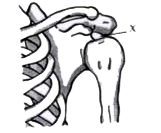What kinds of movements does a germinating seed exhibit?
Step-by-Step Solution:
1. Understanding Germination: Germination is the process by which a seed develops into a new plant. During this process, seeds exhibit specific movements as they grow.
2. Identifying the Parts of the Seed: A germinating seed has two main parts that exhibit movement: the radical and the plumule.
- The radical is the part that develops into the root.
- The plumule is the part that develops into the stem and leaves.
3. Radical Movements: The radical exhibits two types of movements:
- Gravitropic Movement: The radical grows downward in response to gravity. This is important for anchoring the plant and accessing nutrients and water from the soil.
- Hydrotropic Movement: The radical also grows towards areas with higher moisture levels. This ensures that the plant can access water, which is essential for its growth.
4. Plumule Movements: The plumule exhibits:
- Phototropic Movement: The plumule grows upwards towards the light. This is crucial for photosynthesis, as plants need light to produce energy.
5. Conclusion: In summary, a germinating seed exhibits:
- Gravitropic and hydrotropic movements in the radical (root).
- Phototropic movement in the plumule (stem and leaves).
---
- The radical is the part that develops into the root.
- The plumule is the part that develops into the stem and leaves.
- Gravitropic Movement: The radical grows downward in response to gravity. This is important for anchoring the plant and accessing nutrients and water from the soil.
- Hydrotropic Movement: The radical also grows towards areas with higher moisture levels. This ensures that the plant can access water, which is essential for its growth.
- Phototropic Movement: The plumule grows upwards towards the light. This is crucial for photosynthesis, as plants need light to produce energy.
- Gravitropic and hydrotropic movements in the radical (root).
- Phototropic movement in the plumule (stem and leaves).
Topper's Solved these Questions
- CONTROL AND COORDINATIONBOOK - PEARSON IIT JEE FOUNDATIONCHAPTER - CONTROL AND COORDINATIONEXERCISE - MASTERING THE CONCEPTS (Assertions and Reasons)
10 Videos
- CONTROL AND COORDINATIONBOOK - PEARSON IIT JEE FOUNDATIONCHAPTER - CONTROL AND COORDINATIONEXERCISE - ASSESSMENTS TESTS
28 Videos
- CONTROL AND COORDINATIONBOOK - PEARSON IIT JEE FOUNDATIONCHAPTER - CONTROL AND COORDINATIONEXERCISE - TEST YOUR CONCEPTS
37 Videos
- CELL-THE BASIC UNIT OF LIFEBOOK - PEARSON IIT JEE FOUNDATIONCHAPTER - CELL-THE BASIC UNIT OF LIFEEXERCISE - MASTERING THE CONCEPTS (Assertion and Reasons) (Choose the correct option)
5 Videos
- ECOLOGYBOOK - PEARSON IIT JEE FOUNDATIONCHAPTER - ECOLOGYEXERCISE - QUICK RECAP
3 Videos
Similar Questions
Knowledge Check
The germination of a seed is
Aa physical, reversible, desirable change in which energy is producedBa fast, chemical reacțion in which energy is releasedCa slow irreversible, desirable, chemical changeDa fast, irreversible, undesirable chemical changeThe germination of a seed is a
Aphysical, reversible, desirable changeBfast, chemical, desirable changeCslow, irreversible, desirable changeDfast, irreversible, undesirable change.Assertion : Mobilisation of stored food in germinating seeds is triggered by gibberellins.
Reason: In embryo of seed, gibberellins are produced during seed germination.AIf both Assertion and Reason are true and the Reason is a correct explanation of the Assertion.BIf both Assertion and Reason are true but the Reason is not a correct explanation of the Assertion.CIf Assertion is true but the Reason is false.DIf both Assertion and Reason are false.
Dry seeds do not germinate.
View SolutionIdentify the joint 'X' shown in given figure. What kind of movement does it allow? Name the body parts in which it is present.

View SolutionWhat is the role of ABA on the germination of seed?
View SolutionSource of lactose is milk/germinating seeds.
View SolutionSeeds of Tomato do not germinate in its pulp due to
View Solution
